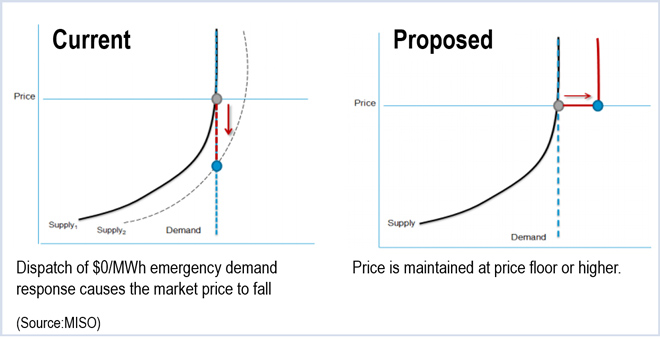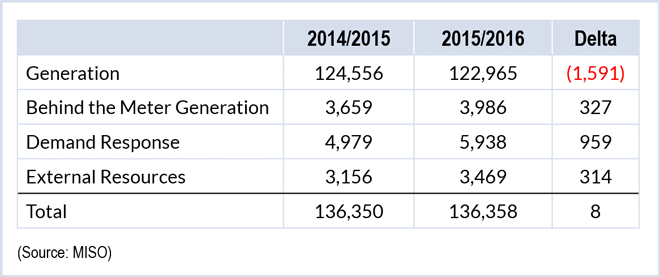By Chris O’Malley
With its reliance on demand response and behind-the-meter generation increasing amid generator retirements, MISO plans to update the way it sets prices during emergency resource offers.
The emergency pricing proposal is “one of the key reforms” that MISO is likely to make next year, Jeff Bladen, executive director of market design, told the Markets Committee of the Board of Directors on Wednesday.

The proposal would involve a price floor, set as the maximum of the emergency resource’s offer cost or the highest available economic offer cost of the last resource cleared prior to the initiation of the maximum generation procedure, MISO said.
More Reliance on DR, LMR
Generation resources are projected to fall with the retirement of coal-fired plants due to the Environmental Protection Agency’s Mercury and Air Toxics Standards, which took effect in April, and its proposed Clean Power Plan, aimed at reducing carbon dioxide emissions.
MISO projects 2015/2016 total generation at 122.9 GW — down nearly 1.6 GW from 2014/2015.
“What you see is a reduction of about a gigawatt-and-a-half of actual generation supply as being relied on to meet our reliability requirements. It’s effectively being replaced by behind-the-meter generation and by demand response and to a lesser degree by external resources,” Bladen told the committee.
Will They Show Up if Needed?
Because it has had ample generation supplies in the past, MISO has no recent history of deploying load-modifying resources (LMR) — and that’s a challenge of its own.
Bladen told the committee that MISO “has questions about the degree to which we can actually rely on emergency and load-modifying resources,” particularly what’s available on a real-time basis. “The challenge here is we have no recent deployment history.”
To better gauge reliability, MISO staff have been running monthly LMR drills with participants. Participation rate has been increasing significantly since 2014. One problem identified has been that participants sometimes do not provide signals to MISO when their LMR or DR resources have been already deployed, leaving uncertainty as to how much relief MISO can count on.
“There’s no testing protocols currently. Even though people are required to provide availability notifications, there’s no penalty, if you like, for not providing availability notifications, although most are very diligent about doing it. So that leads to real concerns about the reliability and availability of those load-modifying resources,” Bladen said.
Todd Ramey, MISO’s head of real-time operations, said as a control room operator, the bottom line is that “I don’t have situational awareness of 2 to 3 GW of planned capacity resources” claimed by members to meet their firm requirements.
Ramey said he plans to seek development of an issues statement to address the lack of information on such resources.
Director Baljit “Bal” Dail echoed concerns, saying the discussion about the reliability of DR and LMR has been going on for a long time.
“In a market that is tightening, I think we need to have much greater clarity about what is going to show up and what isn’t,” Dail said.
Director Michael Curran underscored the urgency, saying: “Aren’t we at the ‘time-is-of-the-essence’ stage? … Time is essentially running out on us.”
‘Cascade’ Effect
Unlike PJM, most of MISO’s DR assets are administered through state programs. As a result, they would not be directly affected if the U.S. Supreme Court lets stand an appellate court ruling voiding the Federal Energy Regulatory Commission’s jurisdiction over DR in energy markets. (See MISO Ponders Large DR Role.)
But Bladen said MISO could be affected if the court’s ruling results in neighboring systems being unable to certify as much DR as they have in the past to meet their requirements.
“It might well mean that some capacity or other resources that we currently rely upon actually become that much more interested in supplying other systems,” Bladen said.
“Maybe prices go up on other systems and that further encourages exports. So the cascade event is likely the one that we would watch mostly closely,” he said.



